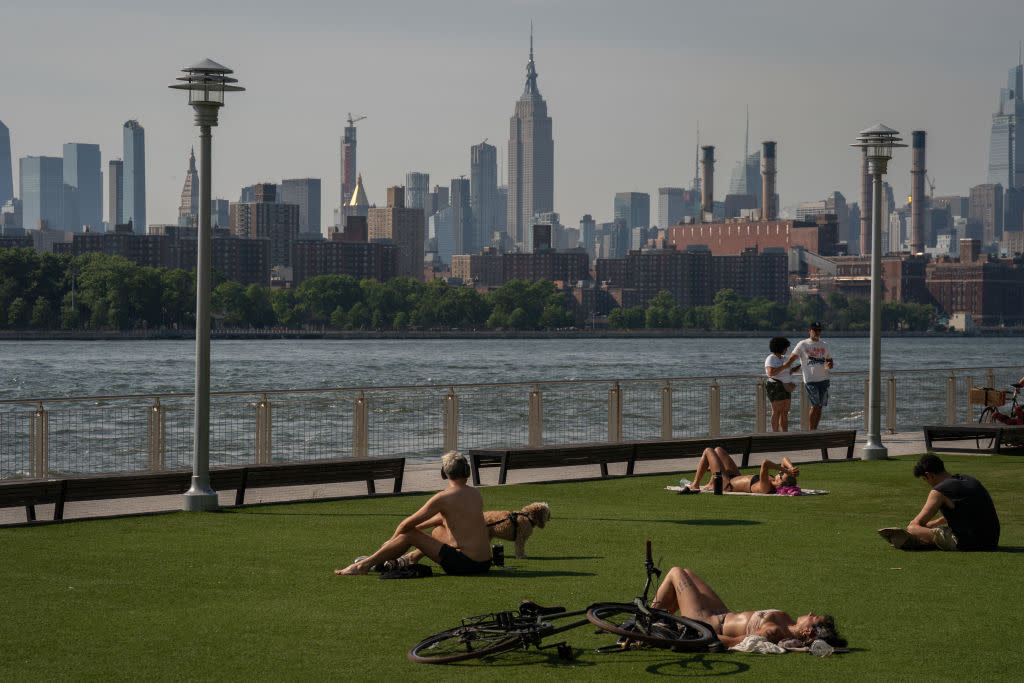How to Know When the Heat Is Getting Dangerous

The Midwest and East Coast are in the middle of a heat dome, with temperatures exceeding 100 degrees. Heat waves are getting hotter as global warming leads to more extreme weather, and 2023 was the hottest year on record. Some scientists say 2024 is poised to be even hotter overall.
As temperatures rise, so do concerns about heat-related illnesses. According to the National Weather Service, heat kills more people in the U.S. than hurricanes, floods, and tornadoes combined. Doctors are also still learning about how poor sleep quality on hot days can increase symptoms of anxiety and depression.
Here's a brief guide to preventing heat exhaustion and heat stroke— and what cities around the U.S. are doing to help residents stay safe.
Why is heat so dangerous?
It's easy to see the sun's effects on the skin, as too much sun exposure can cause a big red burn or rash. And sunburns raise your risk of skin cancers including melanoma. However, inside the body, the heat's stress on various organs can cause long-term health problems, too. For example, dehydration can damage the kidney's ability to excrete toxins, increasing the risk of kidney stones, kidney disease, and even obesity.
How hot is too hot? The Occupational Safety and Health Administration urges caution when temps start to climb above 80ºF. The time of day to avoid the heat as much as possible is between 10 a.m. to 4 p.m.
Read more about the dangers of heat:
What are the symptoms of heat exhaustion and heat stroke?
Heat exhaustion is serious ailment that people should watch out for during a heat wave. Some of the most common symptoms of heat exhaustion include nausea, vomiting, fainting, slurred speech, physical weakness, headache, heart palpitations, and clammy skin. People experiencing these symptoms should be immediately moved to an air-conditioned place. They should remove any heavy clothing, shoes and socks, and wipe themselves down with cold water-soaked washcloths, especially on the neck and face areas. Small, frequent sips of electrolyte-based fluids are encouraged.
The guidelines for kids are similar. Adults, kids and babies, should wear sunglasses, light-colored clothing and wide-brimmed hats to shade themselves from the sun. Babies don't sweat as much as adults do, so when the heat index is like this week's is for much of the U.S.—over 100 degrees—they should stay indoors in a controlled climate for most of the day.
Furry pets struggle in the heat too. For dog walks on pavement, booties can protect paws. Plenty of water bowls for house pets should be around the house or in shady areas outside—but not metal bowls which overheat easily. Shelters often have plastic pools filled with water all over the place so dogs can jump in to cool off.
Heat stroke, meanwhile, is the most serious of the heat-related illnesses. The body stops sweating. Victims may experience seizures or hallucinations. Calling 911 is imperative so the person can get an IV drip to rehydrate. As W. Larry Kenney, a professor of physiology and kinesiology at Penn State University who studies human temperature regulation, told TIME, patients with heatstroke often “don’t know where they are, how they got there, they don’t know what day it is. Eventually, they may lose consciousness, and if their body temperature continues to rise, they would eventually die.”
Read more: How to Monitor and Stay Safe in Extreme Heat, Using the CDC’s New HeatRisk Tool
How to cool down
There are lots of ways to stay cool at home, from blackout curtains that prevent sunlight from entering a space to ceiling fans that keep the air circulating. In terms of staying cool while exercising, runners may want to slow down their pace and opt for a jog instead or a hike in a shaded forest—or switch to an indoor option like yoga.
Here are some of TIME's top tips on staying cool:
What cities and states are doing to help
On a larger scale, municipalities across the affected region are taking steps to help residents stay safe.
Even before this latest heat wave started, Chicago opened its cooling centers in libraries, athletic facilities, and senior centers—air conditioned buildings for residents to sit and cool off.
As the New York Times reports, paramedics in Arizona and Texas are having overheated people climb into what are dubbed “immersion bags,” filled with ice from the chest down—a common tactic for overheated soldiers or athletes. People stay in the bags for 15-20 minutes at a time.
In New York, Governor Kathy Hochul announced that several public pools would be opening earlier than planned and that state parks and beaches would be free on June 19 and June 20 so that residents could jump in the ocean to beat the heat. Water misters are also being added at parks across the state, as experts recommend getting clothes a little bit damp to stay cool.
Write to Olivia B. Waxman at olivia.waxman@time.com.

 Yahoo News
Yahoo News 
